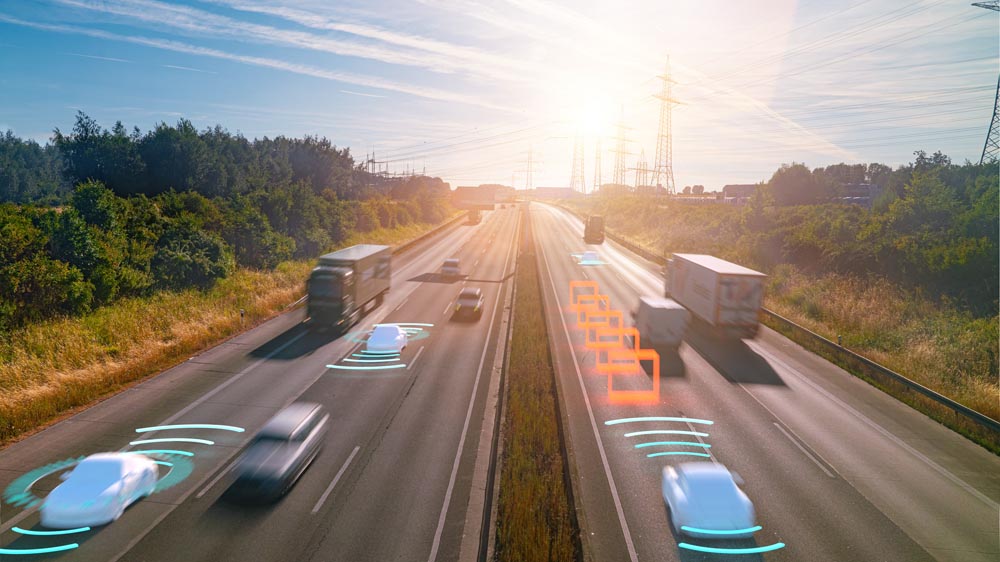Cars that roll through the city without a driver. Delivery vehicles that transport goods as if by magic. The autonomous car is set to revolutionize mobility. But how likely is it that these vehicles will hit the road, asks //next columnist Don Dahlmann.

In the summer of 1925, passers-by strolling along the edge of Broadway and Fifth Avenue were astonished: New Yorkers were already used to a lot of things in the 1920s. Cars had long since become an integral part of life in Manhattan and were no longer unusual. But what the residents saw there was completely new: Without a visible chauffeur or driver, a car was moving through the rush-hour traffic as if controlled by a ghost. In fact, no one was sitting in the large Chandler brand vehicle. The car was driving alone!
In reality, the car was controlled by a small vehicle attached to the bumper of the Chandler. Small electric motors on the steering, brakes and gas pedal received their commands by remote control. Amazingly, this worked, but as the New York Times noted, things also went wrong: "The radio controlled car lurched from left to right, down Broadway, around Columbus Circle and southbound on Fifth Avenue, where it nearly ran into two trucks and a milk truck that took refuge on the curb for safety." The inventor, who went by the slightly bizarre name of Francis Houdina, didn't get much out of the invention - other than a few lines in the press.
Almost 100 years later, however, the time has come: The autonomous car is in the starting blocks. In the U.S. and China, there are already the first cab services that take their customers to their destination without a driver. And US car manufacturer Tesla has announced that its vehicles could soon be fully autonomous as well. But their use is not quite so trivial, because there is a lot of technology behind autonomous vehicles.
Just how great the effort is becomes clear from the list of sensors and cameras without which autonomous driving would not be possible. There are: a front and a rear camera, a stereo camera that looks ahead, a dedicated camera for detecting traffic lights, the car's entire sensor phalanx such as ESP, the distance sensor, speed measurement, road detection, sign recognition, and a 360-degree radar that can additionally detect obstacles. All of this is necessary for the car to see anything at all. Simply reading out the data from these sensors correctly and evaluating it in a fraction of a second still poses problems for engineers.
But the complicated technology that needs to be brought under control is only one side of the story: In the future, cars alone will decide whether a passerby or their own driver dies. So will drivers soon be nothing more than interchangeable personnel for their cars, deciding between life and death?
Philosopher Julian Nida-Rümelin sees things differently. "The car can't decide anything here. There is a rationalistic tradition in modern ethics that assumes there is always a best solution. But I think that is wrong. Rather, we are in a classic dilemmatic situation here."
However, the Ethics Commission of the German Ministry of Transport set up during the last legislative period in the German Bundestag, came to a slightly different conclusion in its report. In dangerous situations, human life always takes precedence over property damage. Which sounds logical, but then also raises the question of whether a car should rather take evasive action when an accident is imminent. Instead of a child, according to this logic, an accident with a parked car is preferable - with the corresponding consequences for the driver.
Alexander Mankowsky, a futurologist at Daimler, disagrees: He believes that an autonomous car is not allowed to do anything except brake. An accident is always a total loss of control. No one can predict all the possible consequences of an accident, nor can they do so at the moment of the accident. Therefore, the only task that an autonomous car should take on in the event of a pileup is that of energy dissipation. The car should reduce the impact energy as quickly as possible, but under no circumstances should it swerve or do anything else.
It quickly becomes clear that one cannot simply transfer valid ethical principles to an artificial intelligence (AI). It may be a principle for all societies in the world that human life is an asset worth protecting. But how far this protection can be pushed - there are different opinions about that. Does an AI need to know about the nuances of social acceptance in the event of death?
The fact that the discussion is being held before the first cars with standard autopilot are even on the road is to be welcomed. However, we must not fall into an anti-technology panic! It is undisputed that autonomous vehicles will prevent a significant proportion of today's accidents. Around 80 percent of all accidents are caused by human error. Drivers are distracted, tired, overwhelmed and, unfortunately, often drunk. That doesn't happen to an AI. In addition, the reaction times of an AI are significantly faster than those of a human. So the AI of autonomous cars will save human lives.
However, we can now define the ethical basis on which it will make its decisions. The Ethics Commission has already created a basis for this. It gives developers a guiding principle without slowing them down technologically. AI will be one of the most important drivers of new industries, and not just in cars. Rules for it are important, but it must not be put into too tight a corset.
Text: Don Dahlmann
Most popular